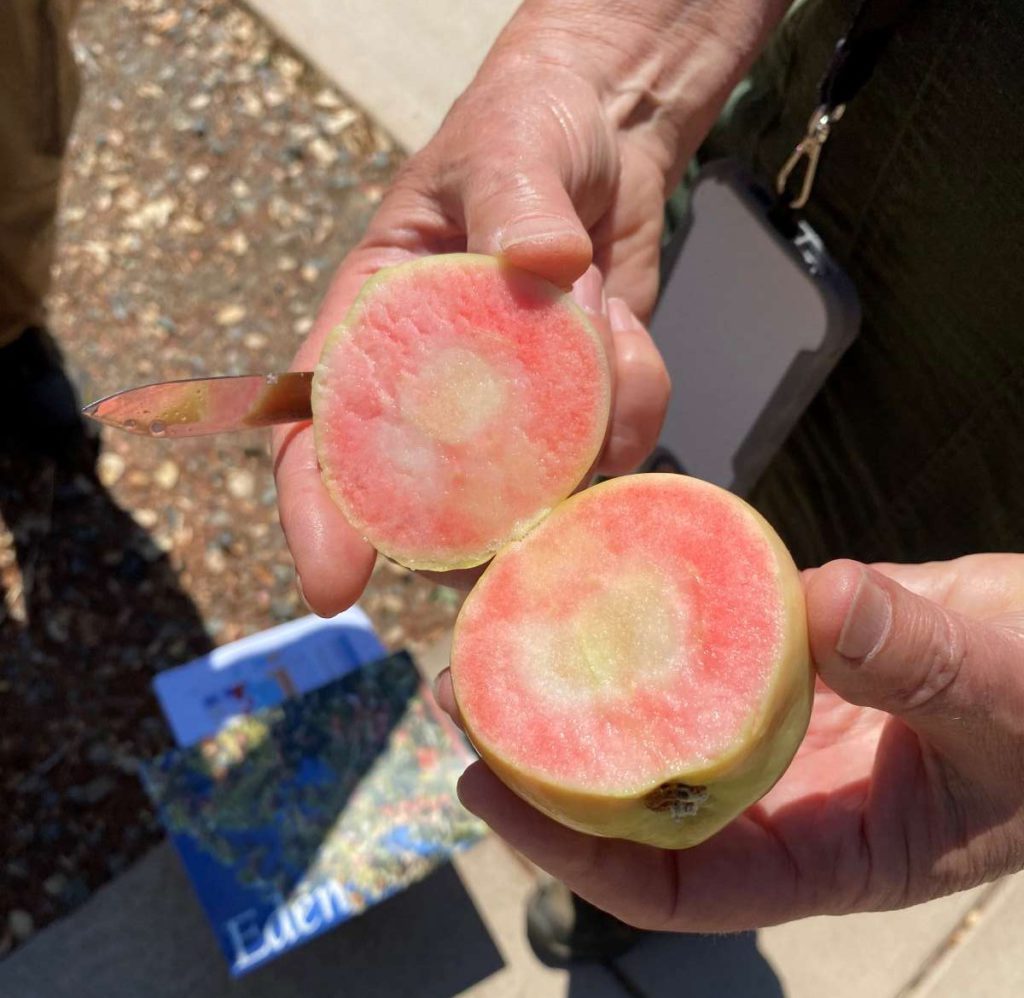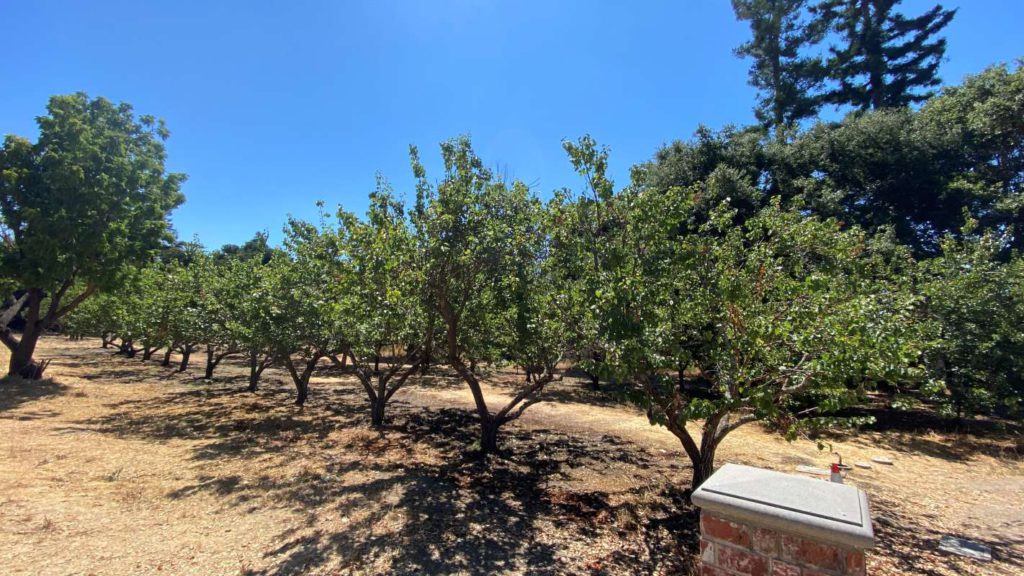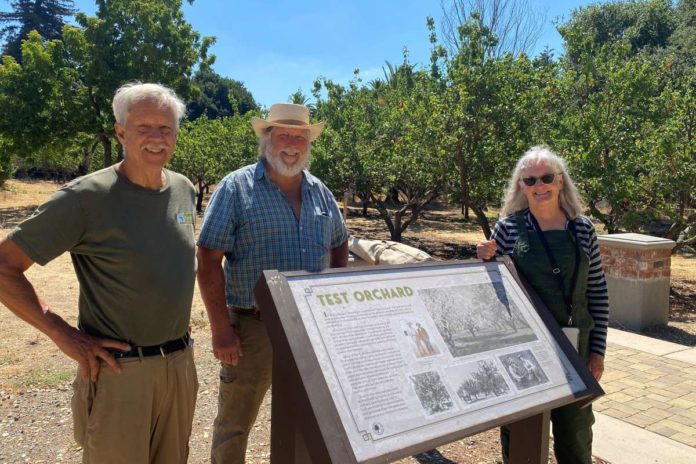It was Halloween, 2024. A fall wind stirred the bare branches of a long-neglected orchard. It sounds like the opening of a spooky movie. Instead, this scene was part of a story of restoration and rebirth, where locals shared their vision with the City of Fremont for a renewed version of the historic California Nursery Test Orchard.
On July 22, 2025, the team, dubbed “CORE” (California Orchard Restoration Experiment), signed a contract with the City as a new nonprofit to officially take charge of the project. Heading the team are Phil Stob as project manager, Janet Barton as lead historian, and Rich Godfrey as advisor. The team also includes soil scientist Zoe Caron and Caroline Harris, chair of Tri-City Ecology Center.
Now all that remains of the test orchard is a small plot in the southwest corner of California Nursery Historical Park in Niles, but in the past the orchard was scattered throughout the 463-acre nursery company. The company was a powerhouse for developing new fruit varieties—now the domain of universities and corporations. Stob says, “A lot of the food we eat now came not from here but was because of what happened here.”
Barton adds, “When John Rock came here in 1884 [and established California Nursery Company], and everyone came here, they had no idea that a tree that did really well in Wisconsin or one in Georgia would grow well here. So they had to test everything before they sold it.”

George C. Roeding bought the company in 1917, and portions of the property were sold off. He also published a fruit growers guide. His son George Jr. inherited the company in 1928, condensing Rock’s orchard into about two acres.
But what is a test orchard? Stob explains, “If you invented a beautiful fruit tree, how do you sell it? You come to these guys…They would plant them all out here and grow them for a couple of years, and then decide whether or not they would put them in the catalog. Then they would have fairly mature trees, and they could take the cuttings and the scions and be true to the trademark. Then they could raise trees. This is what the test orchard was all about.”
For decades, the orchard tested and patented fruits from famous growers such as Albert Etter, a plant breeder from Humboldt County. He contributed over 60 apple varieties, seven of which were selected for sale. Stob estimates the orchard would ship hundreds of thousands of trees every year.
In 1972, City of Fremont acquired California Nursery, which has been a park since 2010. A website developed by Barton states, “The trees there now—apricots, cherries, nectarine—were the beginning of an effort to restore the Roeding Experimental orchard in 2000. Lack of water in recent years has speeded the decline of all of these trees.” Some pre-1970 apple trees also persisted.
The goal is to plant the site with the same varieties that were tested during the orchard’s heyday. Stob says, “This test orchard has always been kept as The Orchard. So it’s always been in [City of Fremont’s] plans. But there wasn’t any plan to maintain it. And there wasn’t anybody to maintain it.”

He continues, “In 2018 we came out and pruned some of these [apricot] trees. It took us months to get permission. They produced a really good crop the next year.” This gave the team hope that a restoration project would also bear fruit.
Dig Deep Farms, originally slated to take over the orchard, unfortunately pulled out from the project. That’s when CORE stepped in. “Now we finally have permission here,” says Stob, “we’re going to recruit more and more people.”
With roots spanning the East Bay Area, they already have a network of support—from the horticulture departments at Merritt, Las Positas and Ohlone Colleges; Master Gardener program; LEAF (Local Ecology and Agriculture Fremont) and Math Science Nucleus. “We have a lot of allies just about everywhere,” says Barton.
In fact, restoration plans take a leaf from LEAF—where Stob is also involved. The orchard will be grown organically and sustainably, with composting from cover crops grown in the winter to enrich the soil, and a native hedgerow to attract birds and bees to prey on pests.
“Fruit off of a tree, if you haven’t had it, is just completely different from what you get in the store,” says Stob. “It’s much more rich in flavor and color and nutrition. Because we’re going to be growing this sustainably, the soil’s going to be much more rich.”
Barton agrees. “Kids don’t know how their fruit grows…It will be great because in the spring you can see the blossoms and it’s just beautiful.”
Trees take three or four years to bear fruit, but it won’t take that long for the orchard to welcome the public for education and tasting, as some trees are already mature. The plan is to replace the dead trees and plant new rows according to pollination requirements and to honor particular fruit growers—adding about 30 new trees per year. Etter varieties are a shoe-in. Stob says, “I went and bought a bunch of Albert Etter apples last year…So I’ve got 27 trees in my backyard in five-gallon buckets.”
“hopefully beyond the time we are here someone can come and find an old Albert Etter apple that has long since disappeared from normal production”
Phil Stob
The team is already looking toward holding a fruit tasting in 2030, the 100th anniversary of the Roeding Test Orchard. “[The public] will be able to come here and pick and try all of those fruits that they will never otherwise see because these are no longer sold in the supermarkets,” says Stob.
The restored orchard will also preserve the germplasm of rare trees for future generations. Trees on private land are vulnerable to forest fires or simply to being sold off. However, says Stob, “If we put them in here and we register them, then people can always find them. And hopefully beyond the time we are here someone can come and find an old Albert Etter apple that has long since disappeared from normal production.”
CORE works on the orchard on Tuesdays between 9am and 2pm. They welcome volunteers with expertise or who are just willing to help. Contact in**@************gy.org.





Stephanie, Thank you for visiting the orchard and letting the community know about it!
Thanks so much for the story, and your lovely spin on it. What was a dark and stormy night for the Orchard it is now Sunshine, Lollipops, and Rainbows. Had more volunteers today who saw the story in the paper, and stopped to spread mulch under the trees. Looks better every week. Always a peaceful time in the orchard. Stop by anytime.